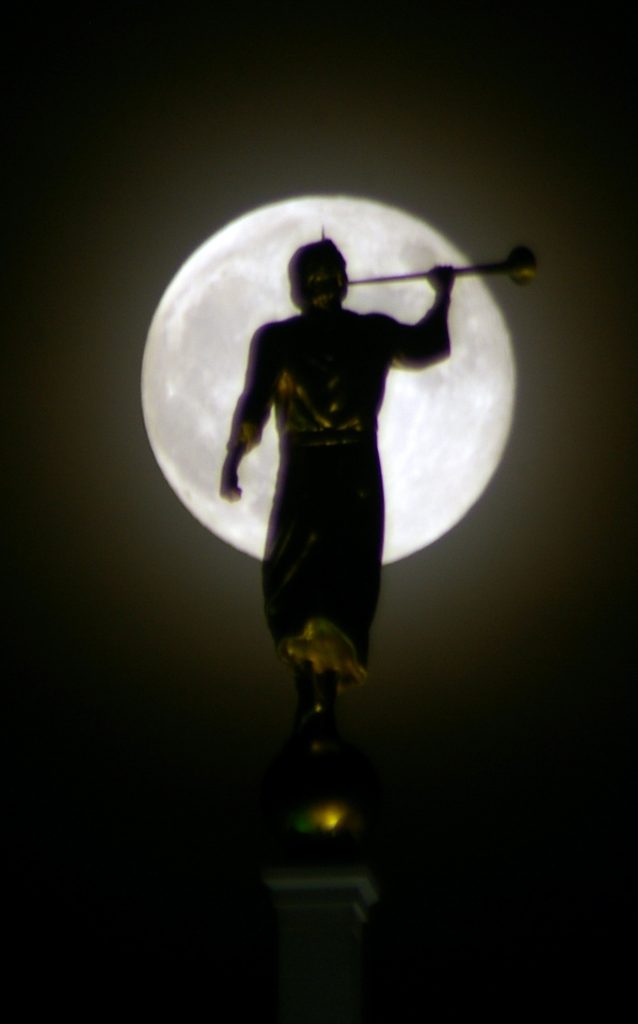Sculpture or Statue?
Sculpture or Statue
There is a division between what constitutes a sculpture, and what is considered a statue. Any three dimensional artwork is a sculpture, but in order to be considered a statue it must be a full figure sculpture of a person. It must also be life-size or larger. If it is full figure but small enough to carry, it is called a statuette or figurine.[1]“Statue,” wikipedia. If the statue is more than twice life size it qualifies as a “colossal statue.”[2]Collins online dictionary: Colossal “2. (in figure sculpture) approximately twice life-size.”; entry in the Getty Art & Architecture Thesaurus® Online Under that definition, a few of these statues do classify as ‘colossal.’
This book will not be doing a run-down of every sculpture that could be identified as being a depiction of the Angel Moroni. We will not, for example, be covering most of the small sculptures created as concepts for the larger statues. We will focus solely on the life-size and larger statues that were created for use on temples, and a few other noteworthy statues of the prophet and angel.

Sculpted or Carved
There are two methods typically used creation of a statue. These two methods are called carving and sculpting.
Carving
The first method is known as carving. Carving is a subtractive method. In carving, the sculptor starts with a large mass of solid material, like a block of marble or a large wood log. In the creation of their desired form, they scrape away material to create their work of art. The final creation is smaller than the original bounding space of the medium the artist began with.
Sculpting
The second method of statue is sculpting. Opposite to carving, sculpting is an ad dative method of creation. This method consists primarily of starting with material, and adding more to it to create the desired shape. While some carving is involved in the process of shaping, this method traditionally produces a sculpture that is larger than the base material you started with.
All of the Statues currently in use on the temples were produced through this second, additive method, being sculpted rather than carved.
This chapter will discuss the history of the use of the statues. Included in this we will examine what came before and how the statues came to be. We will look at the history of each statue, including how and why each was sculpted. In turn we will look at how the statues became a tradition.
Our Criteria
In this chapter we will list the various statues in use on the modern day temples. we will talk about the history, the creation, and the form of each of the different statue models. This book lists more models of statue than prior publications. A new model is defined when one of the following two criteria is met:
The statue has a different sculptor than preceding versions.
The statue has a different pose from its predecessors.
For inclusion in this book, it must also reach one last criteria:
It must be a statue, not a sculpture.
Now let’s discuss the criteria.
Different Sculptor
Anytime a sculpture is created by a new artist, it will be counted as a new statue version. Most of the time these changes are obvious, but it is not uncommon for other articles to attribute a statue or two to the wrong artist.
We will not be including assistant sculptors for any of the versions. Many times research does not turn up any indication as to who, if anyone, may have assisted in a sculpture. When it is known, the assistant will always be noted.
Anytime a sculpture is created by a new artist, it will be counted as a new statue version. We will not be including assistant sculptors for any of the versions. This is because for most of the statues it is not known if there was an assistant involved or not. In those cases where the sculptor stays the same, the new version always meets the second criteria:
Different Pose
Changes in pose are not always immediately apparent, but in each of the statues we will talk about the differences between it and other models. Once the differences have been pointed out, it becomes fairly easy to pick out the different statues when you visit a temple.t always immediately apparent, but in each of the statues we talk about the differences between it and other variations will be pointed out and the reason for indicating a new version will quickly become obvious.
Statue, Not Sculpture
As mentioned earlier, the statue must be life size or larger. Each time a new statue is commissioned, smaller statues are made by the artist to get the design right to begin with. We will not be covering most of these smaller sculptures.
In the following pages we will discuss the history of the creation and use of the statues. Included in this we will examine what came before and how the statues came to be. We will look at the history of each individual model, including how and why each was sculpted. In following chapters we will look at how the statues became a tradition.
There is one unusual instance that I will mention now: there is one statue that is not being counted as a separate model or version of Angel Moroni statue. In this case the statue has the same sculptor as its immediate predecessor, and it has the same pose, it is what is known as a re-scale. While looking identical, it is 3 feet shorter than the original of the same version. While the re-scale was a new sculpture by the original artist, it was also a very pain-staking and faithful reproduction of the larger, preceding statue. For this reason it is considered as being the same statue as the larger original.
Chapter 3 Navigation
